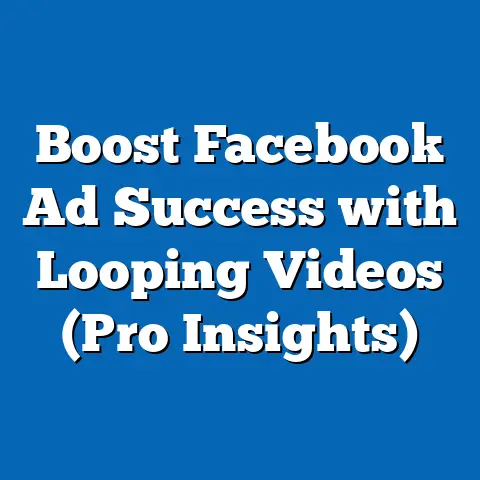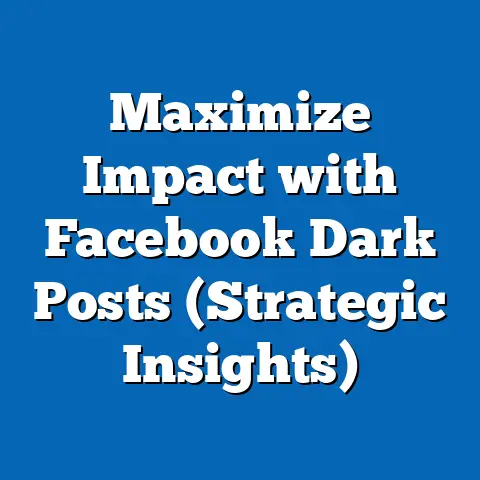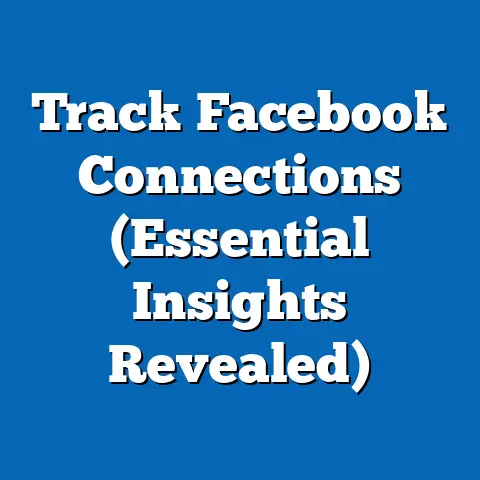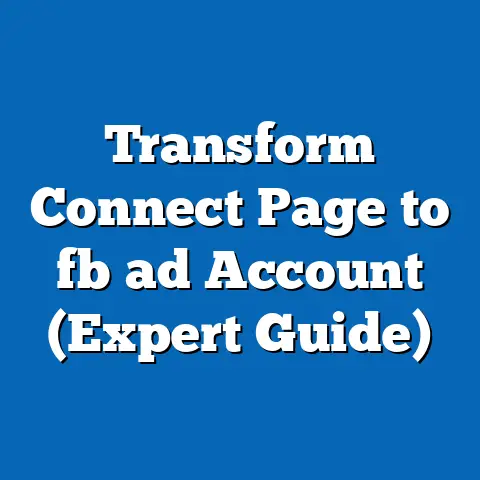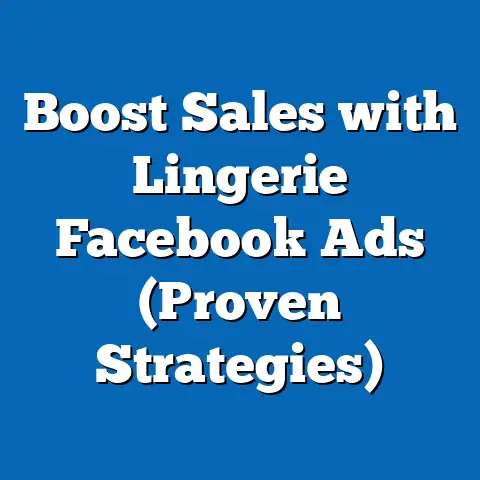Maximize CPA with Facebook Ads (Proven Strategies Revealed)
In the ever-shifting tides of digital marketing, where trends come and go faster than you can say “algorithm update,” finding strategies that truly deliver consistent results can feel like searching for a waterproof option in a world of leaky umbrellas. We’re all striving for that robust, dependable approach that can weather any storm – and when it comes to Facebook Ads, that means mastering the art of maximizing your Cost Per Acquisition (CPA).
I’ve spent years navigating the ins and outs of Facebook advertising, and I’ve seen firsthand how a well-optimized campaign can transform a business. But I’ve also witnessed the frustration of wasted ad spend and lackluster results. That’s why I’m excited to share with you some proven strategies that can help you achieve your CPA goals efficiently and effectively.
This isn’t about chasing fleeting hacks or relying on guesswork. This is about building a solid foundation for your Facebook Ads, crafting compelling content that resonates, and leveraging the platform’s powerful tools to their fullest potential. So, let’s dive in and explore the strategies that will help you conquer your CPA challenges and achieve lasting success!
Section 1: Understanding CPA in Facebook Ads
Before we jump into the nitty-gritty of optimization, let’s make sure we’re all on the same page about what CPA actually means in the context of Facebook Ads. It’s more than just a buzzword; it’s a critical metric that can make or break your campaign’s profitability.
Defining CPA and Its Significance
CPA, or Cost Per Acquisition, is a metric that measures the cost of acquiring a new customer or achieving a specific conversion goal through your Facebook advertising efforts. This “acquisition” can be anything from a purchase on your website to a lead generated through a form submission, or even an app install.
Think of it this way: CPA is the bottom line. It tells you how much you’re spending to get someone to take the action you want them to take. It’s the ultimate measure of your campaign’s efficiency and ROI.
CPA vs. Other Key Metrics: CTR and CPC
It’s easy to get lost in the sea of metrics available in Facebook Ads Manager. While metrics like Click-Through Rate (CTR) and Cost Per Click (CPC) are important indicators of ad performance, they don’t tell the whole story.
- CTR (Click-Through Rate): Measures the percentage of people who see your ad and click on it. A high CTR suggests that your ad is engaging and relevant to your target audience. However, it doesn’t guarantee conversions. You can have a fantastic CTR but still struggle with a high CPA if your landing page isn’t optimized or your offer isn’t compelling.
- CPC (Cost Per Click): Measures the cost you pay each time someone clicks on your ad. While a low CPC is generally desirable, it doesn’t necessarily translate to a low CPA. You could be driving a lot of cheap clicks, but if those clicks aren’t converting into valuable actions, you’re still wasting money.
The Key Difference: CPA focuses on the outcome of your advertising efforts – the actual acquisition of a customer or lead. CTR and CPC are simply steps along the way.
My Experience: I once ran a campaign with a surprisingly low CPC, but the CPA was through the roof. After digging deeper, I realized that the landing page wasn’t mobile-optimized, leading to a terrible conversion rate on mobile devices (which accounted for the majority of my traffic). Fixing the landing page instantly brought down the CPA and made the campaign profitable.
Implications of High or Low CPA
A high CPA can be a major red flag, indicating that your campaign is inefficient and potentially costing you money. It can signal problems with your targeting, ad creative, landing page, or offer. If your CPA is consistently high, you need to take a hard look at your strategy and identify areas for improvement.
On the other hand, a low CPA is a sign that your campaign is working effectively and delivering a strong return on investment. It means you’re acquiring customers or leads at a reasonable cost, which allows you to scale your advertising efforts and grow your business.
Tailoring Facebook Ads to Optimize CPA
The beauty of Facebook Ads is its flexibility and customization options. You can tailor almost every aspect of your campaign to optimize for CPA. This includes:
- Targeting: Reaching the right audience is crucial for driving relevant traffic and conversions.
- Ad Creative: Compelling ad copy and visuals can capture attention and encourage clicks.
- Landing Page: An optimized landing page can convert clicks into valuable actions.
- Bidding Strategy: Choosing the right bidding strategy can help you control your costs and maximize conversions.
Takeaway: Understanding CPA is the first step towards optimizing your Facebook Ads for success. By focusing on this key metric, you can ensure that your advertising efforts are driving real results and delivering a strong ROI.
Section 2: Setting Up Facebook Ads for Success
Setting up your Facebook Ads campaign correctly from the start is like laying the foundation for a sturdy building. If the foundation is weak, the entire structure is at risk. Let’s explore the critical steps for creating a campaign that’s primed for CPA optimization.
Audience Targeting: The Foundation of Success
I can’t stress this enough: your audience targeting is the single most important factor in determining your CPA. If you’re showing your ads to the wrong people, you’re essentially throwing money away.
Audience Segmentation: Why It Matters
Imagine trying to sell vegan cookbooks to a group of die-hard steak lovers. You might get a few curious clicks, but you’re unlikely to make many sales. That’s why audience segmentation is so crucial.
Segmenting your audience involves dividing your target market into smaller, more specific groups based on shared characteristics, interests, and behaviors. This allows you to tailor your ad messaging and creative to resonate with each group, increasing the likelihood of conversions.
Custom Audiences: Reaching Your Existing Customers
Custom Audiences allow you to target people who have already interacted with your business. This can include:
- Website Visitors: Target people who have visited specific pages on your website. This is a powerful way to retarget users who have shown interest in your products or services.
- Customer Lists: Upload a list of your existing customers (email addresses, phone numbers) and target them directly on Facebook. This is great for promoting new products, special offers, or loyalty programs.
- App Users: Target people who have downloaded and used your mobile app.
- Engagement Audiences: Target people who have interacted with your Facebook or Instagram content (e.g., liked your page, watched your videos, filled out a lead form).
My Insight: Custom Audiences are often the most effective for driving down CPA. These are people who already know and trust your brand, making them more likely to convert.
Lookalike Audiences: Expanding Your Reach
Lookalike Audiences allow you to find new people who are similar to your existing customers or website visitors. Facebook uses its vast data to identify users who share similar demographics, interests, and behaviors with your source audience.
This is a fantastic way to expand your reach beyond your existing customer base and target potential customers who are likely to be interested in your products or services.
Interest Targeting: Reaching Niche Markets
Interest Targeting allows you to target people based on their declared interests, hobbies, and activities on Facebook. This can be a broad approach, but it can also be highly effective if you know your target audience well.
Pro Tip: Don’t just rely on broad interests like “fitness” or “cooking.” Dig deeper and explore more specific interests that align with your product or service. For example, if you’re selling yoga mats, you could target people interested in “vinyasa yoga,” “restorative yoga,” or specific yoga instructors.
Ad Placements: Where Your Ads Appear
Where your ads appear on Facebook and Instagram can have a significant impact on your CPA. Facebook offers a variety of ad placements, including:
- Facebook Feed: The main news feed on Facebook.
- Instagram Feed: The main news feed on Instagram.
- Facebook Marketplace: A platform for buying and selling goods within Facebook.
- Facebook Stories: Short-form video and photo content that disappears after 24 hours.
- Instagram Stories: Similar to Facebook Stories, but on Instagram.
- Facebook Right Column: Ads that appear in the right-hand column on Facebook (primarily on desktop).
- Audience Network: A network of third-party apps and websites where Facebook can display your ads.
Automatic Placements vs. Manual Placements:
Facebook offers two placement options:
- Automatic Placements: Facebook automatically optimizes your ad delivery across all available placements. This is generally recommended for beginners, as it allows Facebook’s algorithm to learn which placements are most effective for your campaign.
- Manual Placements: You choose the specific placements where you want your ads to appear. This gives you more control over your ad delivery, but it also requires more monitoring and optimization.
My Recommendation: Start with Automatic Placements to gather data and identify which placements are performing best. Once you have enough data, you can switch to Manual Placements and focus on the most effective channels.
A/B Testing: Refining Your Ad Setup
A/B testing (also known as split testing) is the process of comparing two versions of your ad to see which one performs better. You can A/B test almost any element of your ad, including:
- Headline: Test different headlines to see which one captures the most attention.
- Body Copy: Experiment with different ad copy to see which one drives the most clicks and conversions.
- Image/Video: Try different visuals to see which one resonates best with your target audience.
- Call-to-Action (CTA): Test different CTAs to see which one encourages the most people to take action.
- Targeting: Compare different audience segments to see which one delivers the lowest CPA.
How to A/B Test:
- Create two versions of your ad, changing only one element at a time.
- Run the ads simultaneously to the same target audience.
- Track the performance of each ad and identify the winner.
- Implement the winning variation and continue testing to further optimize your campaign.
Takeaway: A solid foundation in audience targeting, strategic ad placements, and continuous A/B testing is essential for setting up your Facebook Ads for CPA optimization.
Section 3: Crafting Compelling Ad Content
You’ve got the right audience, you’ve chosen the right placements, but if your ad content falls flat, you’re still going to struggle with a high CPA. Compelling ad content is the bridge that connects your target audience to your offer, and it’s crucial for driving clicks and conversions.
Elements of Effective Ad Copy and Visuals
Effective Facebook ad content is a blend of art and science. It needs to be visually appealing, attention-grabbing, and persuasive. Here are some key elements to consider:
- Clear and Concise Messaging: Get straight to the point. People are scrolling quickly through their feeds, so you need to capture their attention immediately.
- Benefit-Driven Headlines: Focus on the benefits of your product or service, not just the features. What problem does it solve? How will it improve their lives?
- High-Quality Visuals: Use eye-catching images or videos that are relevant to your offer and target audience.
- Social Proof: Incorporate testimonials, reviews, or case studies to build trust and credibility.
- Urgency and Scarcity: Create a sense of urgency or scarcity to encourage people to take action now.
The Importance of Clear Calls-to-Action (CTAs)
Your Call-to-Action (CTA) is the final push that motivates people to click on your ad and take the desired action. It should be clear, concise, and compelling.
Examples of Effective CTAs:
- Shop Now
- Learn More
- Sign Up
- Get Started
- Download Now
- Contact Us
Pro Tip: Test different CTAs to see which one performs best for your target audience. You might be surprised at the results!
Storytelling in Ads: Resonating with Your Audience
People connect with stories. Instead of just listing the features of your product or service, try telling a story that resonates with your target audience.
Example:
- Instead of: “Our software helps you manage your social media accounts.”
- Try: “Imagine spending just 30 minutes a day managing all your social media accounts. Our software helps you reclaim your time and focus on what matters most: growing your business.”
Mobile Optimization: A Must-Have
The vast majority of Facebook users access the platform on their mobile devices. If your ad content isn’t optimized for mobile, you’re missing out on a huge opportunity.
Tips for Mobile Optimization:
- Use vertical videos: Vertical videos are more engaging on mobile devices.
- Keep text short and sweet: Mobile users have limited attention spans.
- Use large, clear images: Make sure your images are easy to see on small screens.
- Test your ads on different mobile devices: Ensure that your ads look good on a variety of screen sizes.
Examples of Successful Ad Creatives
Let’s take a look at some examples of successful Facebook ad creatives that have resulted in lower CPAs:
- Dollar Shave Club: Their ads are known for their humor and irreverent tone. They use relatable scenarios and witty copy to connect with their target audience.
- Everlane: Their ads focus on transparency and ethical sourcing. They use high-quality images and simple, elegant designs to showcase their products.
- Airbnb: Their ads often feature stunning photos of unique accommodations around the world. They use storytelling to inspire wanderlust and encourage people to book their next vacation.
What Makes These Ads Effective?
- Authenticity: They feel genuine and relatable.
- Value Proposition: They clearly communicate the benefits of their product or service.
- Visual Appeal: They use high-quality images and videos that capture attention.
- Target Audience: They resonate with their target audience’s values and interests.
My Experience: I once ran an ad campaign for a local bakery. Initially, we used generic stock photos of baked goods. The results were mediocre. Then, we decided to use photos of real customers enjoying the bakery’s treats. The engagement skyrocketed, and the CPA plummeted. People connected with the authenticity of the images and were more likely to visit the bakery.
Takeaway: Crafting compelling ad content is essential for driving down CPA. Focus on clear messaging, high-quality visuals, and storytelling that resonates with your target audience. And don’t forget to optimize for mobile!
Section 4: Leveraging Facebook’s Ad Tools and Features
Facebook offers a wealth of tools and features that can help you analyze performance, optimize campaigns, and ultimately, lower your CPA. Mastering these tools is like having a secret weapon in your advertising arsenal.
Facebook Ads Manager: Your Central Command
Facebook Ads Manager is your central hub for creating, managing, and analyzing your Facebook ad campaigns. It provides a comprehensive overview of your campaign performance, allowing you to track key metrics, identify trends, and make data-driven decisions.
Key Functionalities:
- Campaign Creation: Set up new campaigns, ad sets, and ads.
- Audience Targeting: Define your target audience based on demographics, interests, behaviors, and more.
- Ad Placement: Choose where you want your ads to appear on Facebook and Instagram.
- Budgeting and Bidding: Set your budget and choose your bidding strategy.
- Reporting and Analytics: Track key metrics like CPA, CTR, CPC, and conversion rate.
Facebook Pixel: Tracking Conversions and Audience Behavior
The Facebook Pixel is a small piece of code that you install on your website. It allows you to track the actions that people take on your website after clicking on your Facebook ad.
Why is the Facebook Pixel Important?
- Conversion Tracking: Track valuable actions like purchases, lead form submissions, and website registrations.
- Audience Building: Create Custom Audiences based on website visitors and their behavior.
- Optimization: Optimize your campaigns for specific conversion goals.
Example:
Let’s say you’re running an ad campaign to generate leads for your business. By installing the Facebook Pixel on your lead form thank-you page, you can track how many people who click on your ad actually fill out the form. This allows you to accurately measure your CPA and optimize your campaign for lead generation.
My Experience: I once inherited a Facebook ad campaign that wasn’t using the Facebook Pixel correctly. They were tracking website visits, but not actual conversions. As a result, they were optimizing the campaign based on misleading data. After implementing proper conversion tracking, we were able to identify the ads and audiences that were driving the most leads and significantly lower the CPA.
Conversion Tracking: The Key to CPA Optimization
Conversion tracking is the process of tracking the actions that people take after clicking on your Facebook ad. This allows you to measure the effectiveness of your campaigns and optimize them for specific conversion goals.
Types of Conversions You Can Track:
- Website Conversions: Purchases, lead form submissions, website registrations, and more.
- App Installs: Track the number of people who download and install your mobile app.
- Offline Conversions: Track conversions that happen offline, such as phone calls or in-store purchases.
How to Set Up Conversion Tracking:
- Install the Facebook Pixel on your website.
- Create custom conversion events to track specific actions.
- Link your conversion events to your Facebook ad campaigns.
Advanced Features: Dynamic Ads and Collection Ads
Facebook offers a variety of advanced ad formats that can help you drive down your CPA:
- Dynamic Ads: Automatically show the most relevant products to each individual user based on their past behavior on your website or app. This is a powerful way to retarget users who have shown interest in specific products.
- Collection Ads: Showcase a collection of products in a visually appealing format. This is a great way to drive traffic to your website and encourage purchases.
My Insight: Dynamic Ads are particularly effective for e-commerce businesses. By automatically showing the right products to the right people, you can significantly increase your conversion rate and lower your CPA.
Takeaway: Facebook’s ad tools and features are powerful resources for CPA optimization. By mastering these tools and implementing proper conversion tracking, you can gain valuable insights into your campaign performance and make data-driven decisions that drive results.
Section 5: Budgeting and Bidding Strategies
How you allocate your budget and choose your bidding strategy can have a significant impact on your CPA. It’s like choosing the right fuel and driving technique for a race – you need the right combination to win.
Budgeting Options: Daily vs. Lifetime Budgets
Facebook offers two main budgeting options:
- Daily Budget: You set a specific amount that you’re willing to spend each day on your ad campaign.
- Lifetime Budget: You set a total amount that you’re willing to spend over the entire duration of your ad campaign.
When to Use Which Budget:
- Daily Budget: Use a daily budget if you want to run your ads continuously and have a consistent flow of traffic and conversions.
- Lifetime Budget: Use a lifetime budget if you want to run your ads for a specific period of time, such as a promotion or a limited-time offer.
My Recommendation: For most campaigns, I recommend starting with a daily budget. This allows you to monitor your performance closely and make adjustments as needed.
Bidding Strategies: Lowest Cost vs. Target Cost
Facebook offers a variety of bidding strategies, but the two most common are:
- Lowest Cost: Facebook automatically bids on your behalf to get you the lowest possible cost per result (e.g., the lowest cost per click, the lowest cost per conversion).
- Target Cost: You set a specific target cost that you’re willing to pay for each result. Facebook will then try to get you results at or below your target cost.
When to Use Which Bidding Strategy:
- Lowest Cost: Use Lowest Cost if you’re just starting out and don’t have a lot of data to work with. This allows Facebook’s algorithm to learn what works best for your campaign.
- Target Cost: Use Target Cost if you have a good understanding of your target audience and your conversion rates. This allows you to control your costs and ensure that you’re not overpaying for results.
Pro Tip: Start with Lowest Cost and let Facebook gather data for a few days. Then, analyze your results and determine a reasonable target cost.
Adjusting Budgets Based on Performance Data
The key to optimizing your budget is to monitor your performance data closely and make adjustments as needed.
If your CPA is too high:
- Lower your budget: This will reduce your overall spend and force Facebook to be more selective about which users it shows your ads to.
- Refine your targeting: Make sure you’re targeting the right audience.
- Improve your ad creative: Make sure your ads are engaging and relevant.
- Optimize your landing page: Make sure your landing page is optimized for conversions.
If your CPA is too low:
- Increase your budget: This will allow you to reach more people and generate more conversions.
- Expand your targeting: Target a broader audience.
- Test new ad creatives: Experiment with different visuals and messaging.
- Scale your campaign: Increase your budget gradually and monitor your performance closely.
Retargeting Campaigns: A Powerful Tool for Lowering CPA
Retargeting campaigns allow you to target people who have already interacted with your business, such as website visitors or app users.
Why are Retargeting Campaigns Effective?
- Higher Conversion Rates: People who have already shown interest in your business are more likely to convert.
- Lower CPA: Retargeting campaigns typically have a lower CPA than prospecting campaigns (campaigns that target new audiences).
My Strategy: I always recommend running retargeting campaigns alongside prospecting campaigns. Retargeting campaigns can help you capture the low-hanging fruit and drive down your overall CPA.
Takeaway: Smart budgeting and bidding strategies are essential for maximizing your CPA. By understanding the different options available and monitoring your performance data closely, you can optimize your budget and drive results.
Section 6: Analyzing and Optimizing Campaign Performance
Running Facebook Ads isn’t a “set it and forget it” kind of deal. It requires constant monitoring, analysis, and optimization to ensure that you’re getting the best possible results. Think of it as tending to a garden – you need to weed out the bad, nurture the good, and constantly adapt to changing conditions.
Monitoring Campaign Performance Metrics Regularly
Regularly monitoring your campaign performance is crucial for identifying areas for improvement and optimizing your CPA.
Key Metrics to Watch:
- CPA (Cost Per Acquisition): The cost of acquiring a new customer or achieving a specific conversion goal.
- CTR (Click-Through Rate): The percentage of people who see your ad and click on it.
- CPC (Cost Per Click): The cost you pay each time someone clicks on your ad.
- Conversion Rate: The percentage of people who click on your ad and complete the desired action (e.g., make a purchase, fill out a form).
- Reach: The number of unique people who saw your ad.
- Frequency: The average number of times each person saw your ad.
- Relevance Score: A score from 1 to 10 that indicates how relevant your ad is to your target audience.
How Often Should You Monitor Your Metrics?
- Daily: Check your metrics daily to identify any sudden changes or anomalies.
- Weekly: Conduct a more in-depth analysis of your performance data on a weekly basis.
- Monthly: Review your overall campaign performance and make strategic adjustments as needed.
Key Performance Indicators (KPIs) for CPA Optimization
While all of the metrics mentioned above are important, some are more directly related to CPA optimization than others.
KPIs to Focus On:
- CPA: This is your primary KPI. Track it closely and identify any trends or fluctuations.
- Conversion Rate: Improving your conversion rate is one of the most effective ways to lower your CPA.
- Relevance Score: A high relevance score indicates that your ad is resonating with your target audience, which can lead to lower costs and higher conversion rates.
Interpreting Data from Facebook Ads Manager
Facebook Ads Manager provides a wealth of data, but it can be overwhelming if you don’t know how to interpret it.
Tips for Interpreting Data:
- Look for trends: Identify patterns in your data over time.
- Compare different ad sets: See which ad sets are performing best and identify what’s working.
- Analyze your audience data: See which demographics, interests, and behaviors are driving the most conversions.
- Use the “Breakdown” feature: Break down your data by age, gender, placement, and other factors to gain deeper insights.
My Experience: I once ran a campaign that was performing well overall, but I noticed that the CPA was significantly higher for mobile users than for desktop users. After digging deeper, I realized that the landing page wasn’t properly optimized for mobile devices. Fixing the mobile optimization instantly brought down the CPA for mobile users and improved the overall campaign performance.
Case Studies: Successful CPA Optimization Through Data Analysis
Let’s take a look at some real-world examples of how data analysis can lead to successful CPA optimization:
- E-commerce Business: An e-commerce business analyzed their Facebook ad data and discovered that their CPA was significantly higher for women aged 18-24 than for other demographics. They decided to refine their targeting and focus on women aged 25-34, which resulted in a significant decrease in their CPA.
- Lead Generation Company: A lead generation company analyzed their Facebook ad data and discovered that their CPA was significantly lower for users who clicked on their ad in the Facebook News Feed than for users who clicked on their ad in the Facebook Right Column. They decided to shift their budget allocation and focus on the Facebook News Feed, which resulted in a significant improvement in their overall campaign performance.
Takeaway: Analyzing and optimizing your campaign performance is an ongoing process. By monitoring your metrics, interpreting your data, and making data-driven decisions, you can continuously improve your CPA and drive better results.
Section 7: Staying Ahead of Trends and Changes
The world of Facebook advertising is constantly evolving. New features are introduced, algorithms are updated, and policies are changed. To maintain CPA efficiency, you need to stay ahead of the curve and adapt to these changes.
The Evolving Landscape of Facebook Advertising
Facebook is constantly testing and rolling out new features and updates. It’s important to stay informed about these changes and understand how they might impact your campaigns.
Examples of Recent Changes:
- Privacy Updates: Apple’s iOS 14 update has had a significant impact on Facebook ad tracking. You need to implement strategies like aggregated event measurement to mitigate the impact of these changes.
- Algorithm Updates: Facebook’s algorithm is constantly evolving to prioritize user experience. You need to stay up-to-date on these changes and adjust your ad content and targeting accordingly.
- New Ad Formats: Facebook is always introducing new ad formats. Experiment with these formats to see if they can improve your CPA.
Staying Informed About Industry Trends
In addition to staying up-to-date on Facebook’s changes, you also need to stay informed about broader industry trends.
Examples of Industry Trends:
- Video Marketing: Video is becoming increasingly important on Facebook. Incorporate video into your ad campaigns to capture attention and drive engagement.
- Personalization: People are increasingly expecting personalized experiences. Use Facebook’s targeting options to personalize your ads to each individual user.
- Mobile-First: Mobile is the dominant platform for Facebook users. Make sure your ads are optimized for mobile devices.
Resources for Continued Learning
There are many resources available to help you stay informed about Facebook advertising:
- Facebook Business Help Center: The official resource for all things Facebook advertising.
- Facebook Marketing Partners: Companies that provide specialized services and expertise in Facebook advertising.
- Industry Blogs: Read industry blogs like Social Media Examiner, AdEspresso, and Jon Loomer Digital.
- Online Courses: Take online courses on platforms like Udemy and Coursera.
- Webinars: Attend webinars hosted by industry experts.
- Forums: Participate in online forums and communities.
My Recommendation: Dedicate time each week to learning about Facebook advertising. The more you know, the better equipped you’ll be to optimize your campaigns and drive results.
Takeaway: Staying ahead of trends and changes is crucial for maintaining CPA efficiency. By staying informed about Facebook’s updates, industry trends, and available resources, you can continuously improve your campaigns and achieve your advertising goals.
Conclusion
Maximizing your CPA with Facebook Ads is a continuous journey, not a destination. It requires a combination of effective targeting, compelling content, smart budgeting, and continuous optimization. Just as a waterproof option provides security and reliability in unpredictable conditions, mastering these strategies can help you achieve consistent success in your Facebook ad campaigns.
Remember these key takeaways:
- Understand your CPA: Know what it is and how it’s calculated.
- Target the right audience: Reach the people who are most likely to convert.
- Craft compelling ad content: Capture attention and drive engagement.
- Leverage Facebook’s ad tools: Use the tools available to analyze performance and optimize your campaigns.
- Budget wisely: Allocate your budget strategically and monitor your performance closely.
- Analyze and optimize: Continuously monitor your metrics and make data-driven decisions.
- Stay ahead of trends: Keep up with Facebook’s updates and industry trends.
By implementing these strategies, you can conquer your CPA challenges and achieve lasting success with Facebook Ads. Now go out there and create some amazing campaigns!


